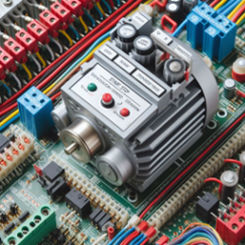
Do you want to learn more about mastering the Start Stop Motor Control Circuits? You can learn all the details about this vital part of electrical engineering by reading this complete guide.
Unravelling the Basics: Start Stop Motor Control Circuits Demystified
I’ll explain the Start Stop Motor Control Circuits and how it works. Each component is essential for the smooth running of the system, from starting the motion to precisely stopping the equipment.
Crafting a Foundation: Key Components in Start-Stop Motor Control
Start Button: Igniting the Power
To activate a motor control circuit, all it takes is pressing the Start button, which is more than just a regular switch. A single push starts the energy flow, orchestrating a web of mechanical and electrical connections. Examining this crucial component further will shed light on its importance and complexities.
The Catalyst of Motion
Consider the Start Button to be a high-performance car’s ignition key. Its single yet significant, function is to release stored energy and start the motor. This is the first step in a carefully choreographed dance between mechanical parts and electrical currents.

Precision in Design
Its complex architecture belies its seeming ease of use. The meticulously designed Start Button guarantees a dependable and immediate connection inside the circuit. This level of accuracy helps the motor control system work more efficiently by differentiating a smooth start from a shaky one.
Integration with Control Logic
It is common for modern motor control systems to have complex control logic, and the Start Button fits right in with all of that. Initiating the predetermined series of actions signals the control system via this gateway. The start-up procedure is guaranteed to be harmonic and managed by this integration.
Safety Measures
The Start Button is more than just a button; it’s a protector. A safe operating environment is ensured, and the danger of accidents is minimized by features like anti-restart systems, which prevent inadvertent reactivation after a shutdown.
Designing an Effective User Interface
The location and design of the Start Button are of utmost importance in applications that need human-machine interaction. Ergonomics and user-friendly interfaces ensure operators can easily and intuitively start the motor.
Continuous Innovation
Similarly, the Start Button changes with the times. Intelligent controls and the integration of the Internet of Things provide new possibilities. Imagine starting a motor from a distance with only a touch on your phone. As it changes to meet the demands of contemporary manufacturing processes, the long-standing Start Button becomes a symbol of progression.
Essentially, the A button is like the beating heart of a motor control circuit; it pulses with the power to get machines moving. For engineers and operators, pressing that button ignites electricity and sets the wheels of industry in motion. It is more than just a switch; it begins a journey.
Stop Button: Halting with Precision
When you want to halt the engine in a controlled manner, however, the halt button becomes the star of the show. To keep motor operations safe and efficient, knowing their function is essential.
Navigating the Circuitry: Understanding the Wiring Schemes
Control Relays: Orchestrating the Movement
In the grand scheme of motor control, control relays are conductors. Examining the circuitry of these relays reveals the coordination that allows motors to run smoothly and efficiently.
Overload Protection: Safeguarding Your System
The avoidance of overload is essential in the field of motor control. We look at how overload protection mechanisms impact your motor control circuit’s longevity and dependability.
Harnessing Expertise: Tips for Optimising Start-Stop Motor Control
Fine-Tuning for Efficiency: Calibration Techniques
Using sophisticated calibration techniques, learn to fine-tune your Start-Stop Motor Control Circuit for maximum efficiency. Ensuring accurate calibration guarantees optimal performance from your machinery.
Troubleshooting Strategies: Ensuring Seamless Operation
The most advanced circuits are not immune to malfunctions. Arm yourself with troubleshooting techniques that allow you to quickly locate and fix problems, maintaining the highest quality motor control circuit.
Conclusion: Mastering the Start-Stop Motor Control Circuit
Mastering the Start-Stop Motor Control Circuit necessitates thoroughly comprehending its wiring, parts, and optimisation strategies. This manual is your road map through this challenging but necessary field of electrical engineering. Take charge, remain knowledgeable, and advance your motor control proficiency.

Leave a Reply